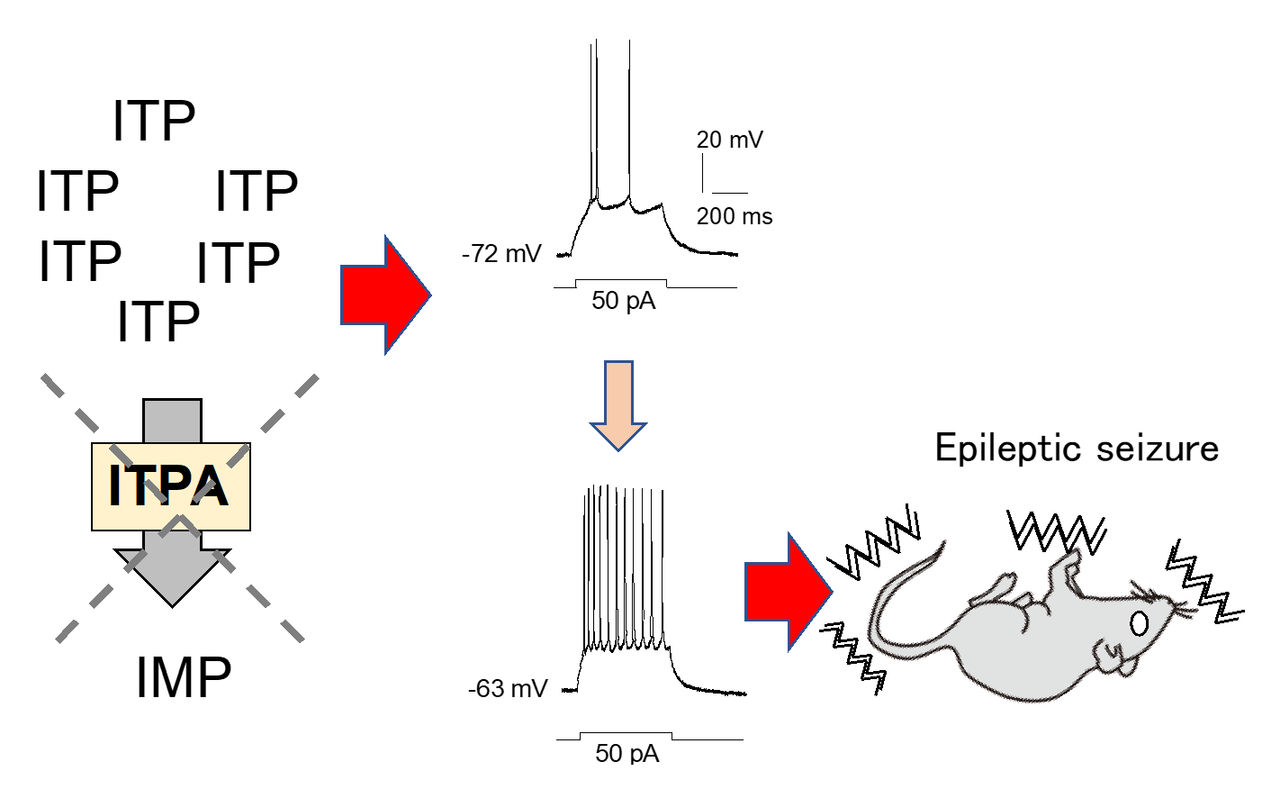研究成果 Research Results
- TOP
- News
- Research Results
- Mechanism connects epilepsy and enzyme deficiency
Mechanism connects epilepsy and enzyme deficiency
Findings also valuable for the 2% of Japanese with less-active version of the key enzyme 2021.01.06Research ResultsLife & Health
Researchers from Kyushu University’s Medical Institute of Bioregulation in collaboration with Nihon University, Yasuda Woman’s University, and Nagoya University now report a better understanding of a mechanism causing epilepsy in infants as the result of a deficiency of an enzyme known as inosine triphosphatase, or ITPA.
The new study could also give insight into possible risks for the 2% of the Japanese population in which both copies of the gene for ITPA produce versions with reduced activity.
Using mice that were genetically engineered such that ITPA production is disrupted only in the nervous system, the researchers found that ITPA deficiency led to a reduction in the negative charge inside the neurons when signals are not being sent, a phenomenon known as depolarization. This depolarization in turn results in frequent excitation of neurons and epileptic seizures in the mice.
The new results indicate that Early Infantile Epileptic Encephalopathy 35 (EIEE35), a neurological disorder characterized by epileptic seizures and associated with deficiency of ITPA, may involve cell membranes becoming more excitable because of depolarization caused by ITPA deficiency.
While mutations in several ion-channel-related genes have been reported to cause some types of EIEE, which are known as genetic neurological channelopathies, ITPA itself is not directly related to ion channels and their control of the difference in charge across the neuron membrane, or membrane potential.
Instead, the researchers suspect that inosine triphosphate (ITP), a molecule that would normally be converted into a different form by ITPA, accumulates in ITPA-deficient cells and affects the ion channels or other molecules related to the channels.
“This is a novel mechanism of EIEE and may help us understand other types of EIEE,” says Daisuke Tsuchimoto, assistant professor of the Medical Institute of Bioregulation and leader of the study.
Even when ITPA is produced, not all types are the same, and one version produced by the human ITPA gene having a so-called single nucleotide polymorphism (rs1127354, 94C>A) is known to exhibit decreased activity in cells.
Though this form is in the minority overall, it is relatively popular in east Asia, and both copies of the gene for ITPA production carry this polymorphism in 2% of Japanese people.
“The results of this study suggest that decreased ITPA activity in this part of the population might influence excitability of neurons under some specific genetic backgrounds or environments and should be investigated further,” comments Tsuchimoto.

Accumulation of ITP increases membrane potential from −72 mV to −63 mV through depolarization, resulting in frequent action potential firing in neurons and epilepsy in mice. © 2020 Koga et al.
###
For more information about this research, see “Neural stem cell–specific ITPA deficiency causes neural depolarization and epilepsy,” Yuichiro Koga, Daisuke Tsuchimoto, Yoshinori Hayashi, Nona Abolhassani, Yasuto Yoneshima, Kunihiko Sakumi, Hiroshi Nakanishi, Shinya Toyokuni, and Yusaku Nakabeppu, JCI Insight (2020). https://doi.org/10.1172/jci.insight.140229
This release is also available in Japanese.
Research-related inquiries
Daisuke Tsuchimoto, Assistant Professor
Division of Neurofunctional Genomics, Medical Institute of Bioregulation
Contact information can also be found in the full release.
- TOP
- News
- Research Results
- Mechanism connects epilepsy and enzyme deficiency































